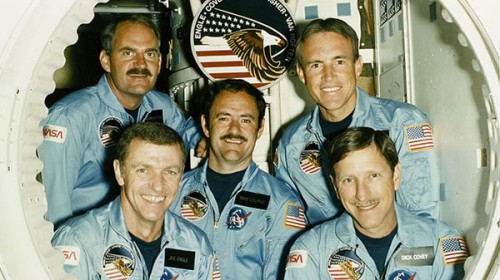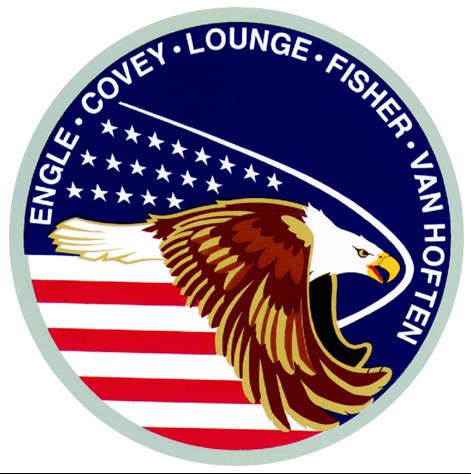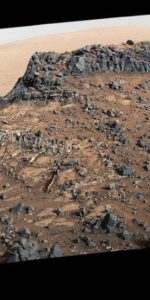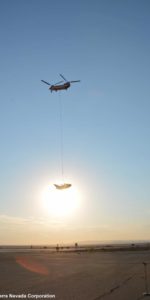
Thirty-two years ago, today, Space Shuttle Discovery roared into the pre-dawn darkness from historic Pad 39A at the Kennedy Space Center (KSC), on an ambitious mission to deploy three communications satellites and retrieve and repair a fourth. Crewed by Commander Joe Engle, Pilot Dick Covey and Mission Specialists James “Ox” van Hoften, Mike Lounge and Bill Fisher, Mission 51I launched during a period of severe thunderstorms and rain in Florida; in fact, conditions were so severe that the astronauts—even in the “gung-ho” halcyon days, before Challenger—doubted that they would fly at all.
Discovery was originally targeted to fly on 24 August 1985, but local rain forced NASA to scrub the attempt. “There weren’t any big thunderstorms,” Covey recalled in his oral history, “but that violated a criteria and it was interesting to watch how the weather criteria changed, and not necessarily for good reasons.” Covey was seated in the right-side couch on the shuttle’s flight deck. To his immediate left, Engle was becoming increasingly irritable. He knew that the showers in question were about 9 miles (15 km) from Pad 39A and he was keenly aware that they had only a few days to achieve an optimum rendezvous with the disabled Syncom 4-3 communications satellite, which they would aim to repair.
A second attempt also came to nothing, when a failure was noted in the shuttle’s Backup Flight Software (BFS) and NASA opted to stand down for a couple of days. Two back-to-back launch cycles and concerns about propellant lines and insulation required engineers’ attention. It also meant that Engle missed launching on his 53rd birthday, which fell on 26 August, although his crew presented him with a cake in the KSC quarters. They had originally intended to give it to him on-orbit, but had unstowed it from Discovery’s middeck and given it to him on the ground.

Despite the levity, however, frustration simmered below the surface. “I can’t believe we scrubbed for those two little showers out there,” Covey reflected, years later. “Anybody with half a lick of sense would have said: Let’s go! This could be a lot worse.” Veteran astronaut John Young, in his capacity as chief of the office, told the crew straight that it was not their place to make judgement calls on the weather. Their knowledge was limited solely to the view from aboard the shuttle. There were other factors, Young said, which also added to the weather mix and the astronauts should focus on the flying.
“Man, we should have gone today,” said Engle. “We had a perfect day.”
“Hey, you guys are in the cockpit,” replied Young. “We’ll make the weather call; you be ready to go fly. When we tell you it’s time to go fly, it’ll be time and you guys will be ready to go.”
Next day, 27 August, conditions were even more dismal, to such an extent that the crew wore yellow raincoats over their blue flight suits when they departed the Operations & Checkout (O&C) Building, bound for the launch pad. The rainfall at one stage was torrential. After being strapped into their seats on Discovery’s flight deck, Lounge and van Hoften were so certain that the launch attempt would be scrubbed that they unfastened their harnesses and took a nap. “Ox was so big that he hung out over the seats as he sat back, and he was very uncomfortable,” said Engle, “and he talked Mike to unstrapping and going down to the middeck, so that he could stretch across both those seats in the back of the flight deck.”
From the pilot’s seat, Covey could hardly believe his eyes as the Launch Control Center (LCC) stepped smartly through the pre-launch checks. He was even more astonished when he was given the go-ahead to power up the shuttle’s three Auxiliary Power Units (APUs) at T-5 minutes. As Covey flipped the switches, he could see sprinkles of rain on Discovery’s forward flight deck windows…
Years later, the go fever was explained by Joe Engle. “They had one more day delay before they had to de-tank,” he said, referring to the expensive and time-consuming process of removing cryogenic propellants from the External Tank (ET). “And that would have been two more days, and the weather forecast was not good for the next day anyway.”
Downstairs, on the shuttle’s middeck, the hum of the APUs woke Bill Fisher. “What’s that noise?” he asked.
“We’re crankin’ APUs,” came the call from the pilots. “Let’s go!”
Fisher, too, was amazed. “Yeah, sure, we’re not goin’ anywhere today,” he retorted. “Why are you starting APUs?”
“Dammit, we’re going,” was the reply from the flight deck. “We’re going to launch. Get back in your seats and get strapped in.”

As the pilots worked through their procedures, a seeming comedy of errors transpired on the aft flight deck, as Lounge and van Hoften scrambled back to the flight deck and into their seats. “Get that strap for me. Where’s my comm lead?” asked one of them. “Get it yourself; I can’t find mine,” replied the other.
On the cusp of daybreak, at 6:58 am EST, Discovery’s three Space Shuttle Main Engines (SSMEs) roared to life, followed by the blazing brilliance of the twin Solid Rocket Boosters (SRBs) as the 20th shuttle mission rose on a pillar of glorious golden flame. “It turned out we launched right through the eye of a hurricane,” van Hoften told the historian. “It coalesced into a hurricane and then we spent the whole time looking down at this major hurricane, going around wiping out Florida.” He was making reference to what became Hurricane Elena, which had originated as a gigantic tropical wave off the coast of East Africa on the 23rd and progressed weakly westwards, paralleling northern Cuba, becoming a tropical storm on the 28th and a hurricane on the 29th.
From the flight engineer’s seat, Mike Lounge had crafted himself a small “mirror” of Mylar and affixed it to the back of his checklist, hoping to watch the reflected launch through the overhead window, just over his left shoulder. “If you hold this mirror, right in your lap,” he said, “you get this great view as the orbiter lifts up and rolls. You’re looking through that window right down at the pad and this huge billow of smoke and flame…and the pad gets smaller and smaller.”
There was little time to be a spectator, of course, as Lounge paged through his checklist, mentally ticking off each of the major milestones: Negative return, then Single-engine TAL and the call which had caused his predecessors on 51F such anxiety: Abort to Orbit. After what seemed like an age, the moment of main engine shutdown occurred and the sensation of weightlessness was felt through a gentle rising against the straps and the quirkiness of the checklist, floating, right in front of his very eyes. That comical sight was arrested very soon by a sight of unimaginable grandeur: Africa, looming large and spectacular in Discovery’s windows. They were in orbit.
In fact, Mission 51I had launched through light rain and it was a point that the astronauts brought up with John Young after they landed.
“Boy, we launched right through rain,” Engle told Young. “I didn’t think we were going to be able to launch.”
“We were flying weather out at the Shuttle Landing Facility,” replied Young. “Why didn’t you tell us it was raining?”
As if to pick fun at Young’s earlier comment, Engle replied: “Our job is to be ready to fly. You guys tell us when the weather’s okay!”
Be sure to “LIKE” AmericaSpace on Facebook and follow us on Instagram & Twitter!





